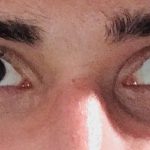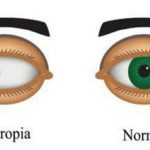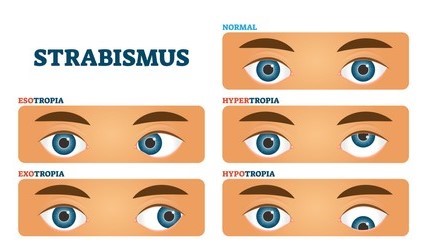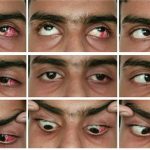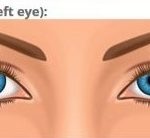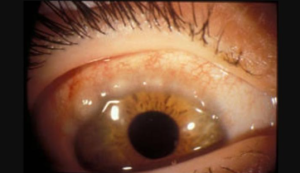Strabismus is a disorder in which both eyes do not line up in the same direction. Therefore, they do not look at the same object at the same time. The most common form of strabismus is known as “crossed eyes”.
Strabismus (eye misalignment) types include
- Turned in (esotropia),
- out (exotropia),
- up (hypertropia) or
- down (hypotropia).
Causes: Six different muscles surround each eye and work “as a team.” This allows both eyes to focus on the same object.
In someone with strabismus, these muscles do not work together. As a result, one eye looks at one object, while the other eye turns in a different direction and looks at another object.
When this occurs, two different images are sent to the brain – one from each eye. This confuses the brain. In children, the brain may learn to ignore (suppress) the image from the weaker eye.
If the strabismus is not treated, the eye that the brain ignores will never see well. This loss of vision is called amblyopia. Another name for amblyopia is “lazy eye.” Sometimes lazy eye is present first, and it causes strabismus.
In most children with strabismus, the cause is unknown. In more than one half of these cases, the problem is present at or shortly after birth. This is called congenital strabismus.
Most of the time, the problem has to do with muscle control, and not with muscle strength.
Other disorders associated with strabismus in children include:
• Cerebral palsy
• Congenital rubella
• Hemangioma near the eye during infancy
• Incontinentia pigmenti syndrome
• Traumatic brain injury
Strabismus that develops in adults can be caused by:
• Diabetes (causes a condition known as acquired paralytic strabismus)
• Graves disease
• Guillain-Barré syndrome
• Injury to the eye
• Shellfish poisoning
• Stroke
• Traumatic brain injury
• Vision loss from any eye disease or injury
• A family history of strabismus is a risk factor. Farsightedness may be a contributing
factor, often in children. Any other disease that causes vision loss may also cause
strabismus.
Overview: People are very sensitive to other individuals’ eye positions. By looking at another person’s eye position, one can very effectively gauge where they are looking. People are also sensitive to eyes that are not looking in the same direction, which is referred to as crossed eyes (strabismus).
Symptoms
• Collapse Section
• Symptoms has been expanded.
• Symptoms of strabismus may be present all the time or may come and go. Symptoms can include:
• Crossed eyes
• Double vision
• Eyes that do not aim in the same direction
• Uncoordinated eye movements (eyes do not move together)
• Loss of vision or depth perception
Treatment
Squint Eye Exercise to Try
There are several exercises that can help improve eye alignment in individuals with squint eyes.
These squint eye exercises can be done at home or with the guidance of a vision therapist.
Pencil Pushups
Pencil pushups are an excellent squint eye exercise for adults and kids. It helps you focus both
your eyes on one single object. The best part about it is that it’s pretty easy to perform. All you
need to do is begin by extending your arm and holding a pencil at a distance with its point facing
away from you. Your attention should be drawn to a letter or number on the side. You need to
drag the pencil toward your nose’s bridge slowly. Keep doing this with focus but not after your
sight becomes fuzzy.
Brock String
Swiss ophthalmologist Frederick Brock created this exercise to enhance eye coordination and it
is one of the best eye exercises for crossed eyes. You’ll need three different coloured pearls on a
thread or string approximately five feet long. Attach the thread’s one end to a fixed object, such
as a seat back or a railing. The pearls should be evenly spaced apart. Clamp the thread’s opposite
end firmly against your nose.
As you move your attention from pearl to pearl, you ought to notice a recurring pattern. The
pearl you are observing will show up on its own at the point where two similar threads cross,
along with duplicates of the other pearls to create an X. If you notice the threads overlapping in
front of the pearl or behind the pearl, your eyes are not properly focused on the pearl. Make sure
the X is available at all pearls except the last one. You can continue the activity by moving the
pearls around on the thread.
Barrel Cards
Barrel cards is yet another exercise to reduce squint eyes and is a concentration method, just like
the other two we mentioned above. You need to draw three barrels on each card. On one side of
the card, draw the barrels in red color, and on the other, draw them in green. The barrels come in
small, medium, and big sizes as well. With the smallest barrel closest to you, you have to hold
the card against the bridge of your nose. The card must be vertical for one eye to view the red
barrels and the other to see the green barrels.
Concentrate on the barrel that is furthest from your nose. The red and green barrels should merge
to create a single image. Maintain your attention there for 5 seconds, then move it to the centre
circle. Retain your concentration for five seconds when you notice that the coloured barrels have
merged into one image. Once you’ve completed all three sizes of barrels, continue this procedure
for the closest barrels.
There are myriads of types of vision issues you can suffer from, and one of them is squint eyes or
crossed eyes. It has various other names like lazy eyes and Strabismus. If you or your kid is
suffering from crossed eyes, you don’t have to worry much as you can get rid of it. Don’t wait
and watch consult with an expert pediatric ophthalmologist for management of squint earliest.
Treatment ranges from glasses to occlusion therapy, surgeries and eye exercises after surgeries but it
needs to be done in a particular sequence, in particular time period- Critical time of visual
development – till 7 years of age for best results in children and most importantly under the guidance
of an expert strabismologist. So, treatment options can be
• Only glasses
• Only Surgery
• Glasses with Surgery
• Convergence and vergence exercise after Surgery
• Occlusion therapy tO prevent lazy eyes and double vision
• Botulinum toxin injection in patients with acquired squint due to nerve paralysis.
If it is not treated on time it could cause lazy eye (amblyopia), loss of binocular single vision. With
lazy eye vision will be variably lesser in the affected eye. Only straight alignment of eyes can be
achieved at any age.
How Is Squint Eye Treated?
Treatment ranges from glasses to occlusion therapy, surgeries and eye exercises after surgeries
but it needs to be done in a particular sequence, in particular time period- Critical time of visual
development – till 7 years of age for best results in children and most importantly under the
guidance of an expert strabismologist. So, treatment options can be
Only glasses
Only Surgery
Glasses with Surgery
Convergence and vergence exercise after Surgery
Occlusion therapy tO prevent lazy eyes and double vision
Botulinum toxin injection in patients with acquired squint due to nerve paralysis.
If it is not treated on time it could cause lazy eye (amblyopia), loss of binocular single vision.
With lazy eye vision will be variably lesser in the affected eye. Only straight alignment of eyes
can be achieved at any age.

